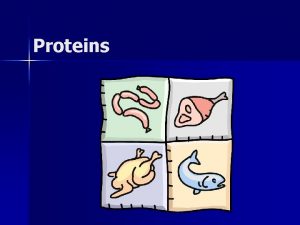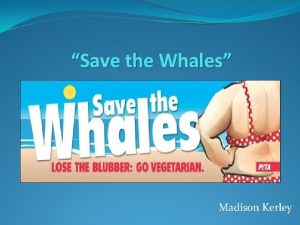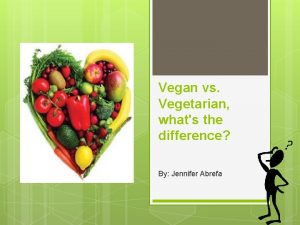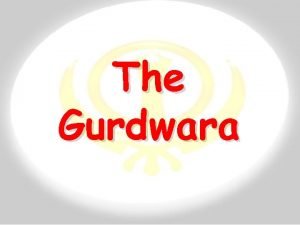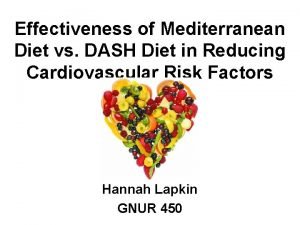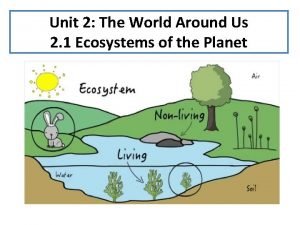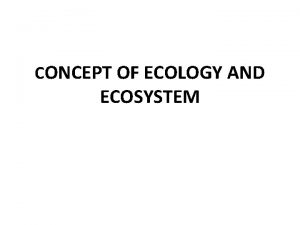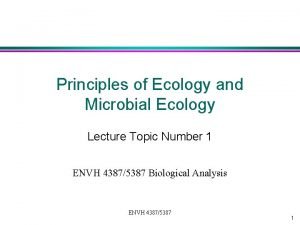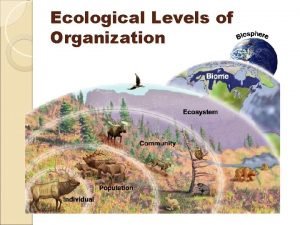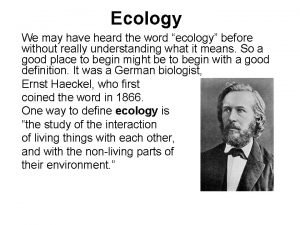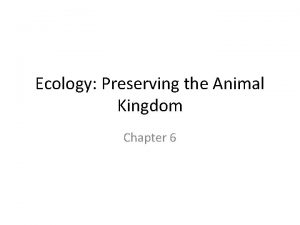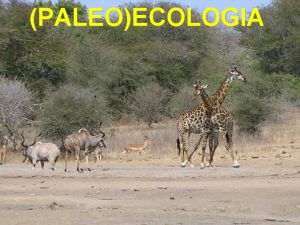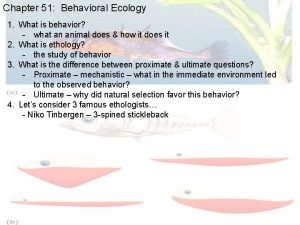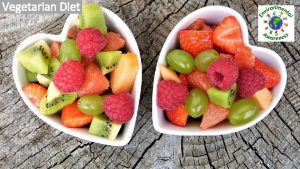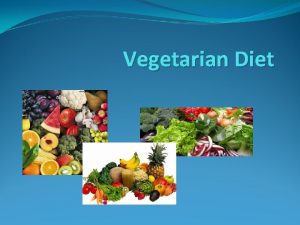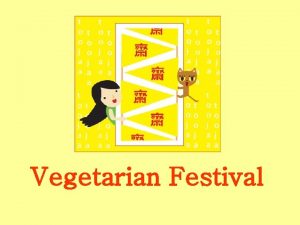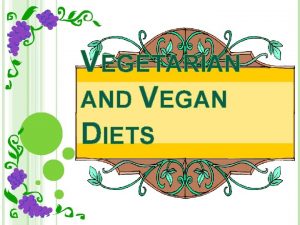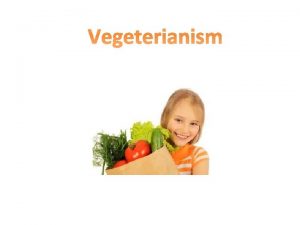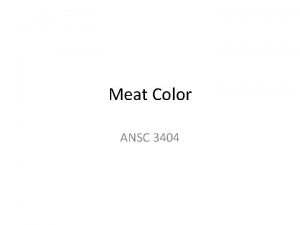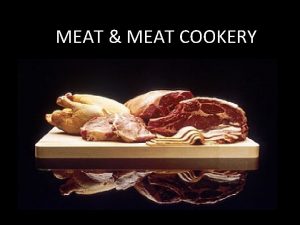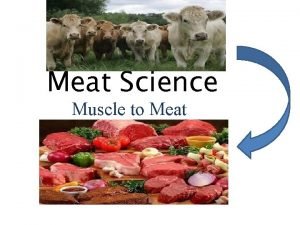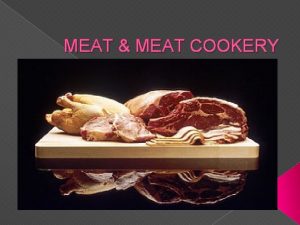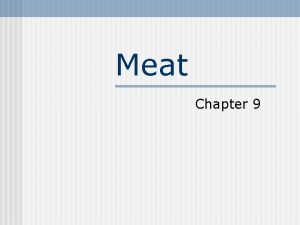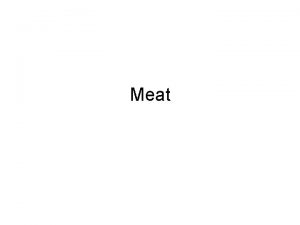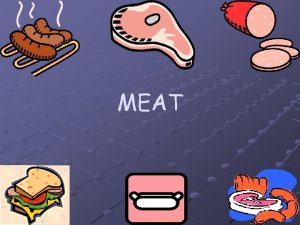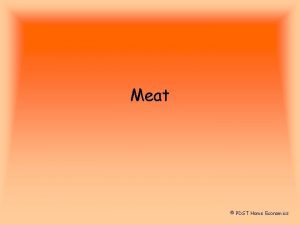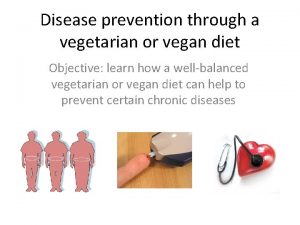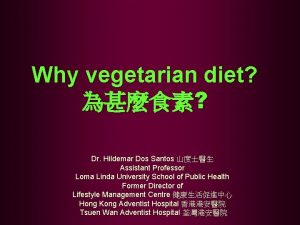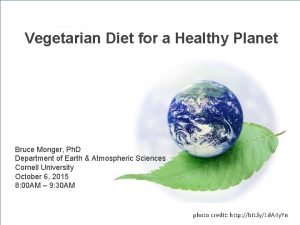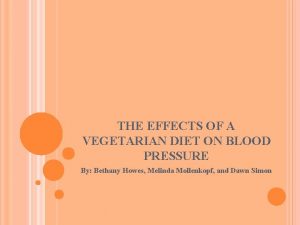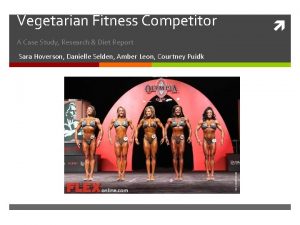Ecology of Meat Diet vs Vegetarian Diet What


































- Slides: 34

Ecology of Meat Diet vs. Vegetarian Diet • What do ecological principles tell us about availability of energy to humans? – Pyramids Summarize food chains & Trophic levels • Numbers • Biomass • Energy loss in food chains

Short Food Chain (Three Trophic Levels) Third Trophic Level Wolf (Carnivore) Second Trophic Level Deer (Herbivore) First Trophic Level Grass (Autotroph)

PYRAMID OF NUMBERS BLUEGRASS PASTURE BIRD 3 GRASSHOPPER GRASS 708, 624 5, 542, 424 CARNIVORE HERBIVORE AUTOTROPH

PYRAMID OF BIOMASS BLUEGRASS PASTURE (LB/ACRE) BIRD 1 GRASSHOPPER GRASS 54 4, 190 CARNIVORE HERBIVORE AUTOTROPH

PYRAMID OF ENERGY LION CARNIVORE DEER HERBIVORE PLANT AUTOTROPH SOLAR ENERGY Energy Lost 1 10 9 90 100 9, 900 10, 000 CALORIES

Human Food Chains • What do human do to increase available energy? – Humans generally shorten food chains and make them simpler • Shorter food chains -

Affect of Feeding at Lower Trophic Levels Number of Adult Humans Supported for a year Adult One Human 600 Trout 180, 000 Frogs 54 million Grasshoppers 2000 tons of Grass Thirty Nine Hundred Two Thousand

Could we support more humans if we fed at lower trophic levels (ate more plants and less animals)? • How many vegetarians can be fed on land needed to support 1 person eating a meat base diet? – Vegetarians (10 -20) • Acres needed to feed – non-vegetarian (4 acres) – vegetarian ( ½ acre or less)

Caveats with Plant Based Diets • Let’s eat grass! • What kind of plants can we eat? – High in digestible carbohydrates (sugars and starches) – Corn, wheat, rice , potato, sugarcane, cassava (manioc)

What concerns are there with plant based diets? • Plants provide calories • May lack essential amino acids – Essential Amino acids 20 -21 • (9 or 10 we cannot synthesize) • Plant protein – Typically lack 1 or 2 essential AA’s – Grains low in lysine – Soybeans • high lysine • low in methionine • Animal protein contains the essential AA’s

Comparison plant and animal proteins • • • • Food Eggs Fish Chicken Beef Cow’s Milk Brown Rice Soybean Wheat Corn Polished Rice Manioc Broccoli Potato Complete Proteins Incomplete Proteins Ranking 100 75 72 70 60 55 45 40 35 38 35 30 30

Protein Consumption in Different Parts of the World • How much protein does a person require? – Recommended Daily Allowance (RDA) – RDA per adult mixed diet = 56 grams – (RDA) is dependent upon body weight: – 0. 8 grams of protein per kilogram (2. 2 lbs) of body weight for adults • 174 lb adult 63 grams of protein daily • 138 lb adult 50 grams daily. – Protein consumption in different parts of the world

Livestock Production World-wide • Enough grain produced to feed everyone - if distributed equally • World-wide - major effort to increase livestock production 1950 -1990 – Number of livestock tripled 5. 3 to 15 billion – Chickens increased the most (3 to 11 billion) – Human population doubled • How did the increase in livestock production occur? – Increase in grain and Agriculture energy allocated to livestock production

Grain and Energy Costs to Produce Meat • Traditional livestock production – Animals turned things people could not eat into things they could eat • Ruminants: cattle, sheep, goats – Grass, crop wastes • Pigs and fowl – Cannot use grass – Use crop waste, kitchen scraps • United States Meat Production – Grain is converted to livestock – Inputs used to produce one kg of meat, eggs, or cheese

Energy Cost for Meat production – Ratio: kcal of energy to produce a kcal of protein • (kcal of fossil fuel: kcal protein) • Beef 54: 1 • Lamb 50: 1 • Pork 17: 1 • Turkey 13: 1 • Chicken 4: 1 • Grain 3. 3: 1 • One half of USA agriculture energy goes into livestock • What percent of our fossil fuel do we import? 65%

Conversion of plant to Animal Protein (USA) • 41 million tons of plant protein to produce 7 million tons of animal protein – 26 million tons grain – 15 million tons grass • Many people in the poor portions of the world cannot afford the “luxury” of converting grain to meat

Percent of Calories From Starch

Antibiotics • Why add antibiotics to livestock feed? – 4% increase in growth • Annual Use of antibiotics: – Livestock 11 -17 million pounds per year – Human 3 million pounds per year • Why Worry About Livestock Use of Antibiotics? • The Union of Concerned Scientists –” overuse of antibiotics in intensive animal agriculture is a main contributor to the development of a myriad of new treatment-resistant pathogens afflicting both animals and humans. ”

Human Diseases, Antibiotics And Beef Range Fed Beef (3/4) 1. Grass and other forage crops 2. Microbes (bacteria adapted to forage) Feed lot (grain) 100 days (1/4) 1. Starch Digests More Quickly than Forage 2. Less “cud chewing” less saliva (one-half) Annually 73, 000 illnesses Contaminated Beef 63 death Antibiotics (subtherapeutic) 12 -37% Liver Abscesses E. coli 0157: H 7 In cattle Increased Rumen Acidity “stomach ulcers” Bacteria (Fusobacterium necrophorum) Enters the bloodstream

Meat Diet (Summary of Concerns) • Large amount of energy is need to produce meat • Grain is converted to animal products so less grain is available for human consumption – Grain and soybeans fed to livestock in the USA: would feed 800, 000 – 1, 400, 000 people – USA more than 50% of grain is fed to livestock – World wide 38 -40% of grain is fed to livestock • As world consumption of meat increases grain available to feed poorer nations declines

Animal Wastes • Animal wastes generated are not treated – 7 billion livestock in USA (livestock produced 20 x’s as much waste as humans in the United States)

Energy Cost for Meat production – Ratio: kcal of energy to produce a kcal of protein • (kcal of fossil fuel: kcal protein) • Beef 54: 1 • Lamb 50: 1 • Pork 17: 1 • Turkey 13: 1 • Chicken 4: 1 • Grain 3. 3: 1 • One half of USA agriculture energy goes into livestock • What percent of our fossil fuel do we import? 65%

Fat in Our Diets • Supplement to Vegetarian vs. Meat Diet

Kinds of Fats • Saturated – Acid –C-C-C-Methyl Group – No double bonds between carbons • Monounsaturated – Fatty acid with a single double bond – Acid –C-C-C=C- C-C-Methyl Group

Kind of Fats • Polyunsaturated – Fatty acid with more than one double bond – Acid –C-C-C=C-C-Methyl Group • Trans Fat - hydrogenated – Hydrogen added to the double bond carbons

What kind of fat should we consume? • Small Amounts of Saturated fats (7%) of total fat intake • Sources: whole-milk dairy products, fatty meats, tropical oils, partially hydrogenated vegetable oils and egg yolks • Increase cancer and heart disease risk • Unsaturated Fatty Acids – Essential Fatty Acids – Omega-3 and omega -6 Fatty Acids

Structure of Fatty Acids Omega 6 fatty acid Methyl Group Double Bond Acid Group Omega 3 fatty acid

Omega-6 Fatty Acids • Omega-6 fatty acids – Source: Corn, safflower, sunflower, soybean, and cottonseed oil (cooking and baking oils) – Functions: Important for brain function, Stimulate bone and hair growth, necessary to maintain reproductive function

Omega 3 fatty acids • Omega-3 fatty acids – grains, fresh fruits and vegetables, fish, olive oil, garlic – Functions: • • Cognitive and behavioral function Inflammatory diseases (osteo-arthritis) Reduce heart diseases Reduce LDL’s’ (Bad cholesterol) increase HDL’s (Good Cholesterols) – Ratio: Total/HDL –average 4. 5 – Good ratio 2 to 3 • Slower cancer cell growth

Ratio of omega-6 to Omega-3 • Ratio of omega-6 fatty acids to omega-3 fatty acids – Good: one to four times more omega-6 fatty acids than omega-3 fatty acids – USA Diet: 11 to 30 times more omega-6 fatty acids than omega-3 fatty acids

Fat In Our Diets • How much fat should we consume – 30% of calories from fat – 7% saturated – 2, 000 calorie diet (600 calories) – 12 calories/g of fat = 50 g (3. 5 saturated) • Mc. Donald's Double Quarter lb with Cheese – Calories 770 – Fat 47 g – Calories from fat 430 (56%) – Saturated Fat 39 g

Vegetarianism and Health • Vegetarians have blood cholesterol levels: – 14% less than non-vegetarians – vegans are 35% lower • Vegetarian’s risk of dying from heart disease is less than half that of a non-vegetarian • Medical costs in USA directly attributable to meat consumption - $60 -120 billion • Meat eaters have triple the rate of high blood pressure as compared to vegetarians • The obesity rate: – General population 18%, – Vegans is 2%. • Men who consume large amounts of dairy products have a 70% increased risk for prostate cancer

Things to think about • 1. 1 billion people world wide are over weight • 1 billion people world wide have an inadequate diet • 60 million people starve to death each year

References: http: //www. animalplace. org/why. html • • 2. Resnicow, K. , Barone, J. , Engle, A. , et all, "Diet and Serum Lipids in Vegan Vegetarians: A model for Risk Reduction, " Journal of the American Dietetic Association 91 (1991): 447 -453. See also Sacks, F. M. , Ornish, D. , et al. , "Plasma Lipoprotein Levels in Vegetarians: "The Effect of Ingestion of Fats from Dairy Products, " Journal of the American Medical Association 254 (1985): 1227 -41 3. Resnicow, et al. , "Diet and Serum Lipids in Vegan Vegetarians. " See also Messina and Messina, The Dietitian’s Guide to Vegetarian Diets 4. Phillips, R. , et al. , "Coronary Heart Disease Mortality among Seventh-Day Adventists with Differing Dietary Habits, " American Journal of Clinical Nutrition 31 (1978): S 191 -8; Burr, M. , et al. , "Vegetarianism, Dietary Fiber, and Mortality, " American Journal of Clinical Nutrition 36 (1982): 873 -7 5. Halweil, Brian, "United States Leads World Meat Stampede, " Worldwatch Issues Paper, July 2, 1998 6. Ophir o. , et al. , "Low Blood Pressure in Vegetarians. . . , " American Journal of Clinical Nutrition 37 (1983): 755 -62; see also Melby, C. L. , et al. , "Blood Pressure in Vegetarians and Non. Vegetarians: A Cross-Sectional Analysis, " Nutrition Research 5 (1985): 1077 -82 7. Mokdad, A. , et al. , "the Spread of the Obesity Epidemic in the United States, " Journal of the American Medical Association 282 (1999): 1519 -22 8. Health Professionals Follow-up Study, reported in "Dairy Products Linked to Prostate Cancer, " Associated Press, April 5, 2000. 9. Washington Post: Gains From Antibiotic Ban Noted; Benefits to Danish Farm Animals Come at 'Marginal' Cost, March 27, 2002, David Brown
 Management of kwashiorkor
Management of kwashiorkor Save the whales peta
Save the whales peta Indirect speech examples
Indirect speech examples Www.youtube.com
Www.youtube.com Semi vegetarianism
Semi vegetarianism Are sikhs vegetarian
Are sikhs vegetarian Market forms of pork
Market forms of pork Dash diet or mediterranean diet
Dash diet or mediterranean diet Andros barrier reef case study
Andros barrier reef case study What is population ecology
What is population ecology Organismal ecology
Organismal ecology Ecology unit review
Ecology unit review Chapter 53 population ecology
Chapter 53 population ecology Population characteristics ecology
Population characteristics ecology Cultural ecology ap human geography
Cultural ecology ap human geography Difference between ecosystem and ecology
Difference between ecosystem and ecology Stable community
Stable community Levels of ecological organization foldable
Levels of ecological organization foldable What is exponential growth in ecology
What is exponential growth in ecology The word ecology
The word ecology Mutualism definition biology
Mutualism definition biology Population ecology def
Population ecology def Neutralism definition
Neutralism definition Ecology auto parts tijuana
Ecology auto parts tijuana Ecological pyramid of biomass
Ecological pyramid of biomass What is ecology
What is ecology What is ecology
What is ecology Ecology preserving the animal kingdom
Ecology preserving the animal kingdom Chapter 2 section 1 organisms and their relationships
Chapter 2 section 1 organisms and their relationships An organisms rank in a feeding hierarchy
An organisms rank in a feeding hierarchy Sepkoski
Sepkoski Kinesis ecology
Kinesis ecology Organismal ecology
Organismal ecology 5 levels of organization ecology
5 levels of organization ecology Lesson 1 introduction to ecology answer key
Lesson 1 introduction to ecology answer key
